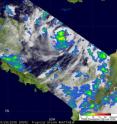NASA satellites see Tropical Storm Matthew grow quickly, warnings up in Central America
An instrument on NASA's Aqua satellite noticed increasing colder cloud top temperatures of tropical depression 15 in the south-central Caribbean just before it strengthened into Tropical Storm Matthew late on Sept. 23. The TRMM satellite also spotted heavy rainfall within the system. Matthew is now headed to the western Caribbean and watches and warnings are in place as Matthew may continue to strengthen. Cloud top temperatures indicate the strength of the storm to forecasters. The colder the cloud top temperatures, the stronger the convection and uplift. When cloud top temperatures drop, as they did in Atmospheric Infrared Sounder (AIRS) imagery captured on Sept. 23 at18:53 UTC (2:53 p.m. EDT) it indicates the storm is gaining strength. At that time, Matthew's maximum sustained winds were near 40 mph. In the image, the coldest cloud top temperatures (colder than -63 Fahrenheit) appeared around the center of Matthew's circulation already giving the appearance of an eye. The AIRS infrared image on Sept. 24 at 3:05 a.m. EDT showed a concentrated area of strong thunderstorms around Matthew's center as the sustained winds had increased to 50 mph.
AIRS has the ability to determine cloud top and sea surface temperatures from its position in space aboard NASA's Aqua satellite. Cloud top temperatures help forecasters know if a storm is powering up or powering down and Matthew is powering up.
In addition to the Aqua satellite, the Tropical Rainfall Measuring Mission (TRMM) satellite flew nearly above Matthews's location on Sep. 24 at 0159 UTC (9:59 p.m. EDT Sept. 23) capturing data used in a rainfall analysis done at NASA's Goddard Space Flight Center in Greenbelt, Md. TRMM Microwave Imager (TMI) data analyzed from this orbit showed moderate to heavy rainfall southwest of MATTHEW's center of circulation.
At 11 a.m. EDT on Sept. 24, Matthew's maximum sustained winds were near 50 mph, and strengthening is expected in the warm Caribbean waters, so the National Hurricane Center said that Matthew could become a hurricane by Saturday. Meanwhile at 11 a.m. Sept. 24, Matthew was located about 80 miles east of Cabo Gracias a Dios, Nicaragua, near 14.4 North and 82.2 West. It was moving west at 20 mph, and had a minimum central pressure of 1001 millibars. Just 15 hours before, its minimum central pressure was 1005 millibars, and a drop in pressure indicates a strengthening storm.
A hurricane watch is in effect for Puerto Cabezas, Nicaragua to Limon, Honduras including the offshore islands. A tropical storm warning is in effect for Puerto Cabezas, Nicaragua to Limon, Honduras including the offshore islands.
A tropical storm warning is in effect for Puerto Cabezas, Nicaragua northward to the border with Honduras including the offshore islands and the coast of Honduras including the offshore islands. A tropical storm watch is in effect for the coast of Belize, while a hurricane watch is in effect for Puerto Cabezas, Nicaragua to Limon, Honduras. Hurricane conditions are possible between 11 p.m. EDT tonight and 11 a.m. EDT Saturday in that watch area.
Tropical storm-force winds are expected to reach the coastal warning areas during the afternoon of Sept. 24, and a storm surge is expected to produce flooding and dangerous surf. Expected rainfall amounts of 6 to 10 inches are forecast with isolated amounts to 15 inches.
According to the National Hurricane Center in Miami, on the forecast track the center of the Matthew is expected to be near the Nicaragua/Honduras border late Friday or early Saturday morning then move over land in northern Honduras on Saturday. Updates on Matthew can be found at the National Hurricane Center's web page: www.nhc.noaa.gov.
Source: NASA/Goddard Space Flight Center
Articles on the same topic
- GOES-13 Satellite sees Lisa a tropical storm...for nowFri, 24 Sep 2010, 21:07:57 UTC
- NASA's CloudSat satellite sees a powerful heat engine in Typhoon MalakasFri, 24 Sep 2010, 20:43:49 UTC
- GOES-13 sees tropical depression 15 form in the south-central Caribbean SeaThu, 23 Sep 2010, 20:24:09 UTC
Other sources
- GOES-13 Satellite sees Lisa a tropical storm... for nowfrom PhysorgFri, 24 Sep 2010, 23:21:21 UTC
- NASA satellites see Tropical Storm Matthew grow quickly, warnings up in Central Americafrom PhysorgFri, 24 Sep 2010, 22:35:15 UTC
- NASA's CloudSat satellite sees a powerful heat engine in Typhoon Malakasfrom PhysorgFri, 24 Sep 2010, 22:14:12 UTC
- NASA sees important cloud-top temperatures as Tropical Storm Malakas heads for Iwo Tofrom PhysorgThu, 23 Sep 2010, 21:28:29 UTC
- GOES-13 sees tropical depression 15 form in the south-central Caribbean Seafrom PhysorgThu, 23 Sep 2010, 19:56:16 UTC

